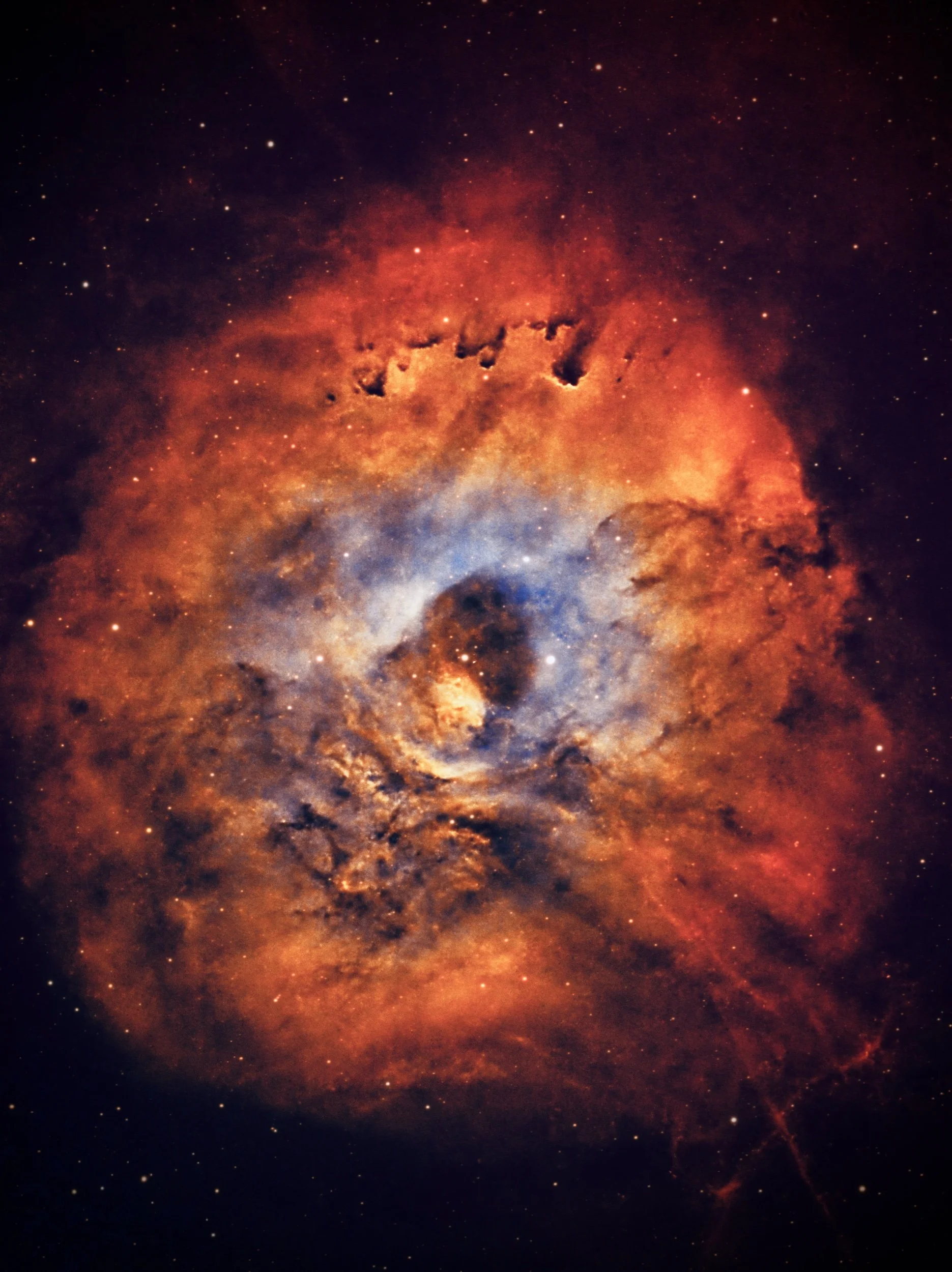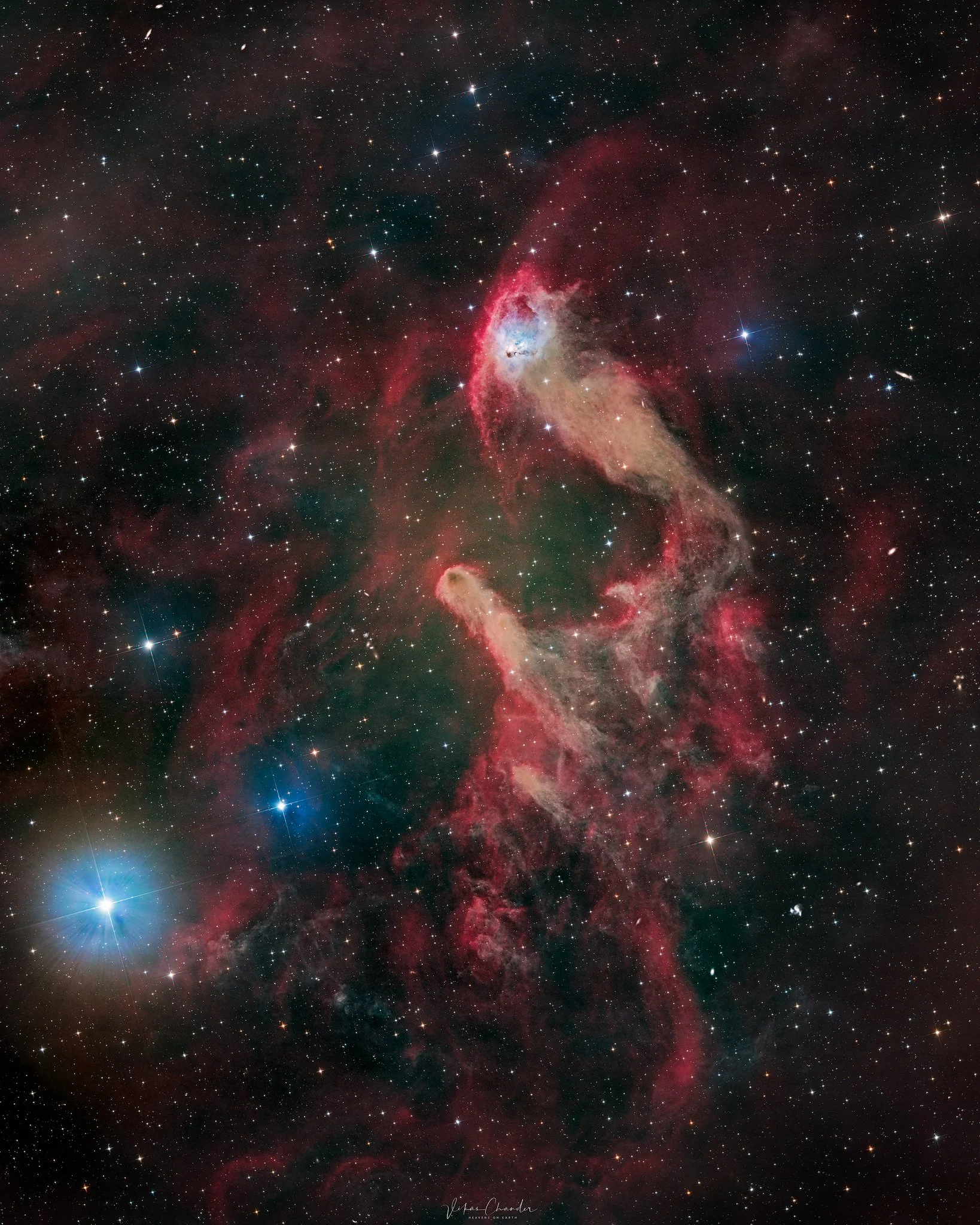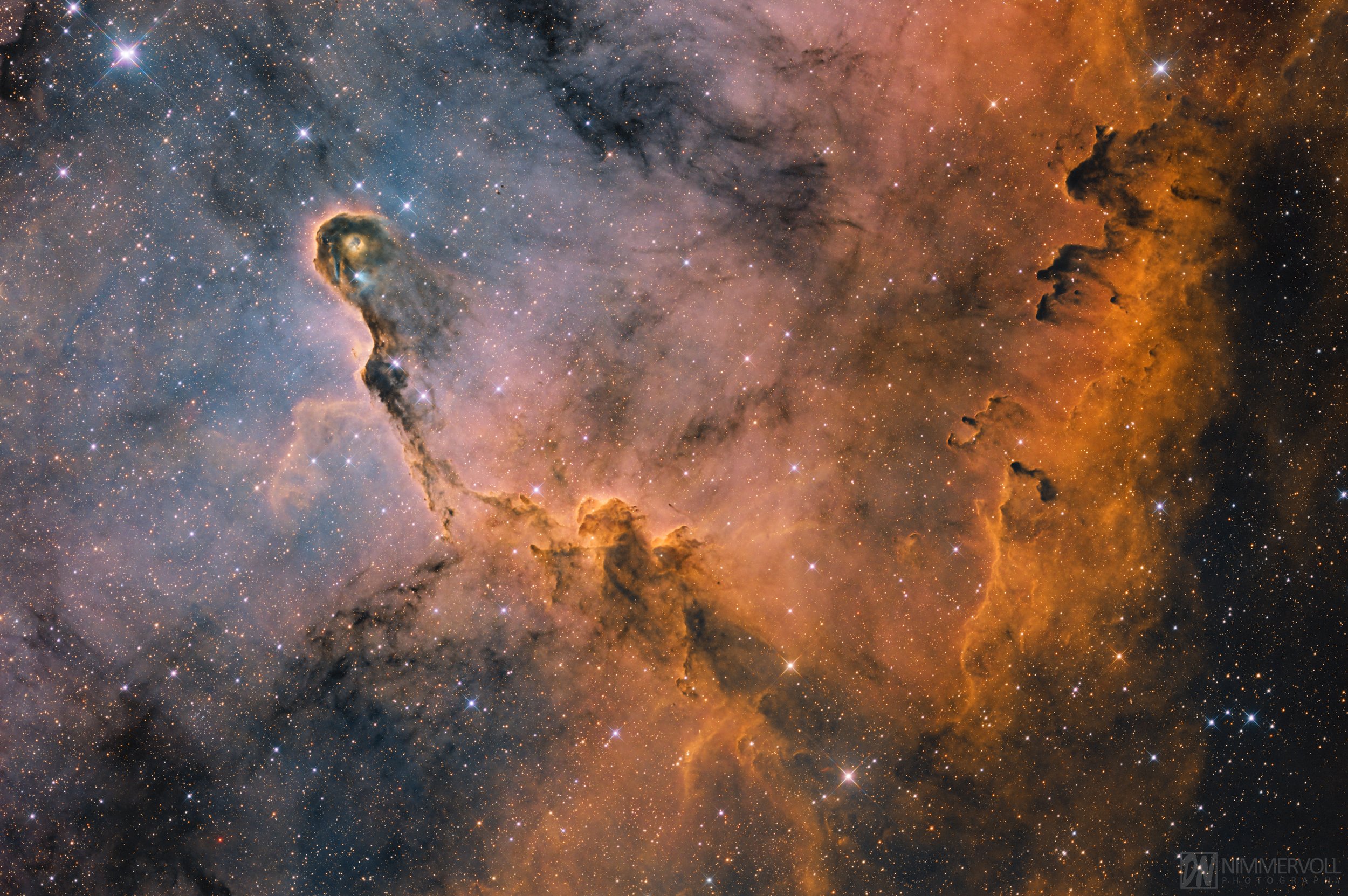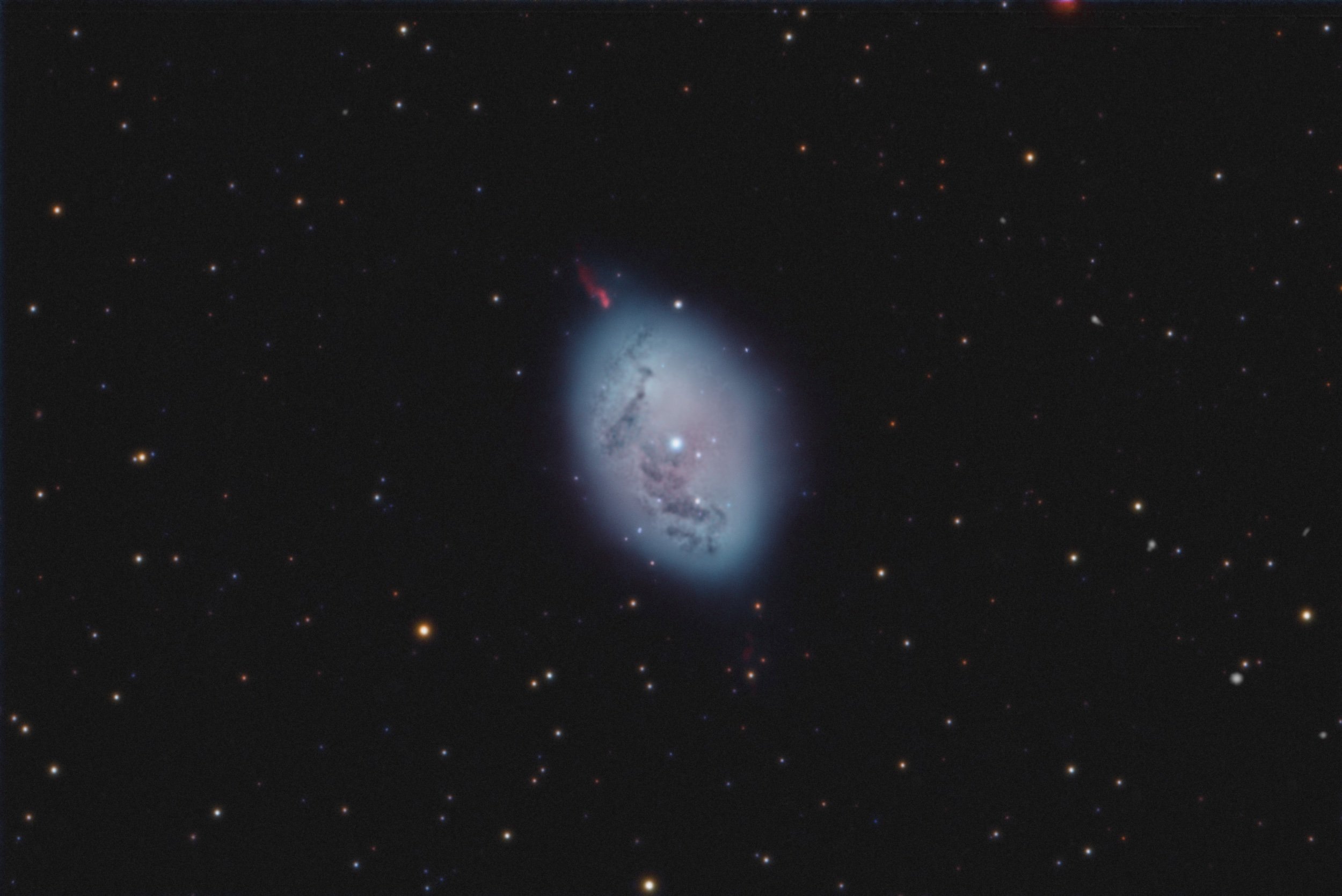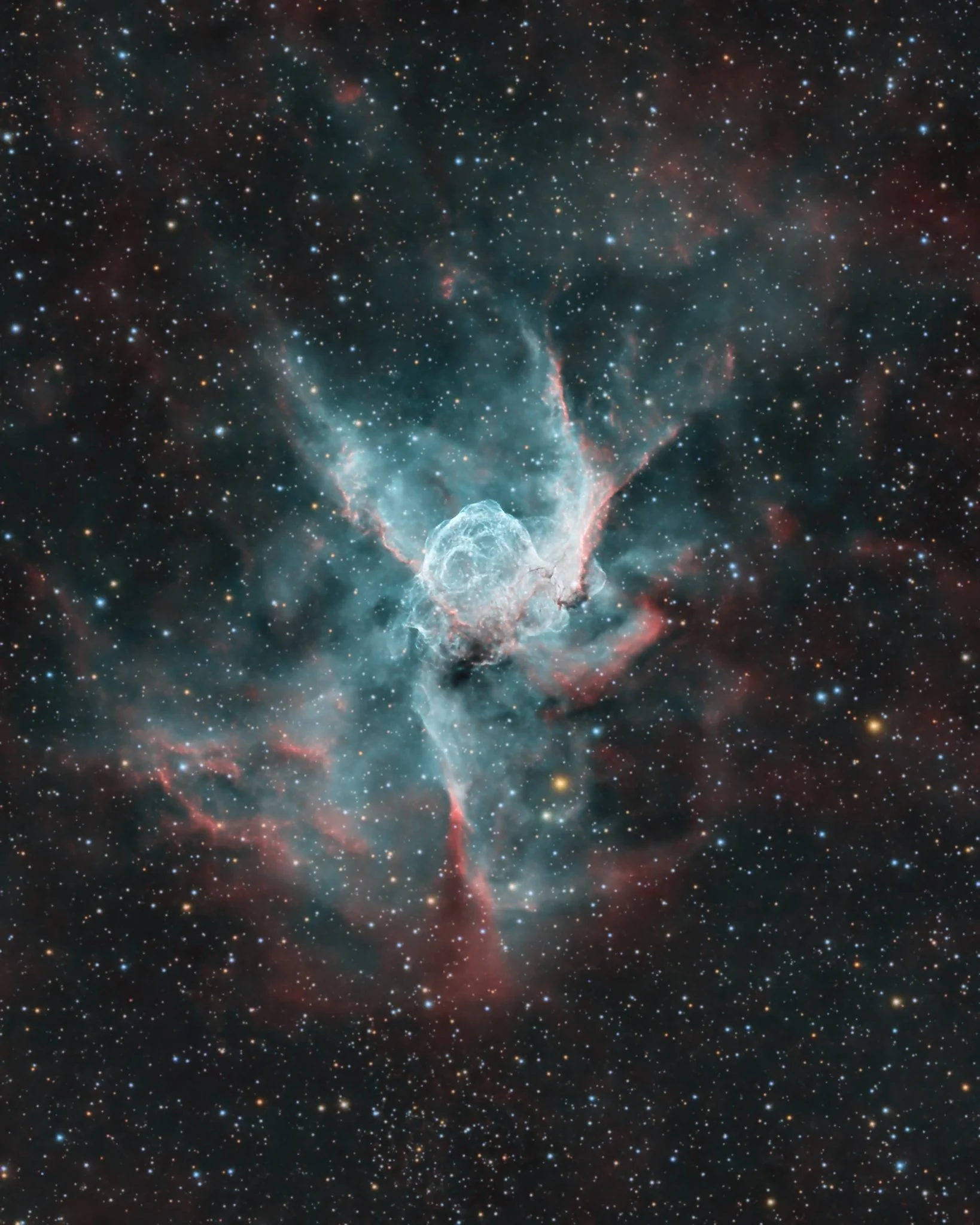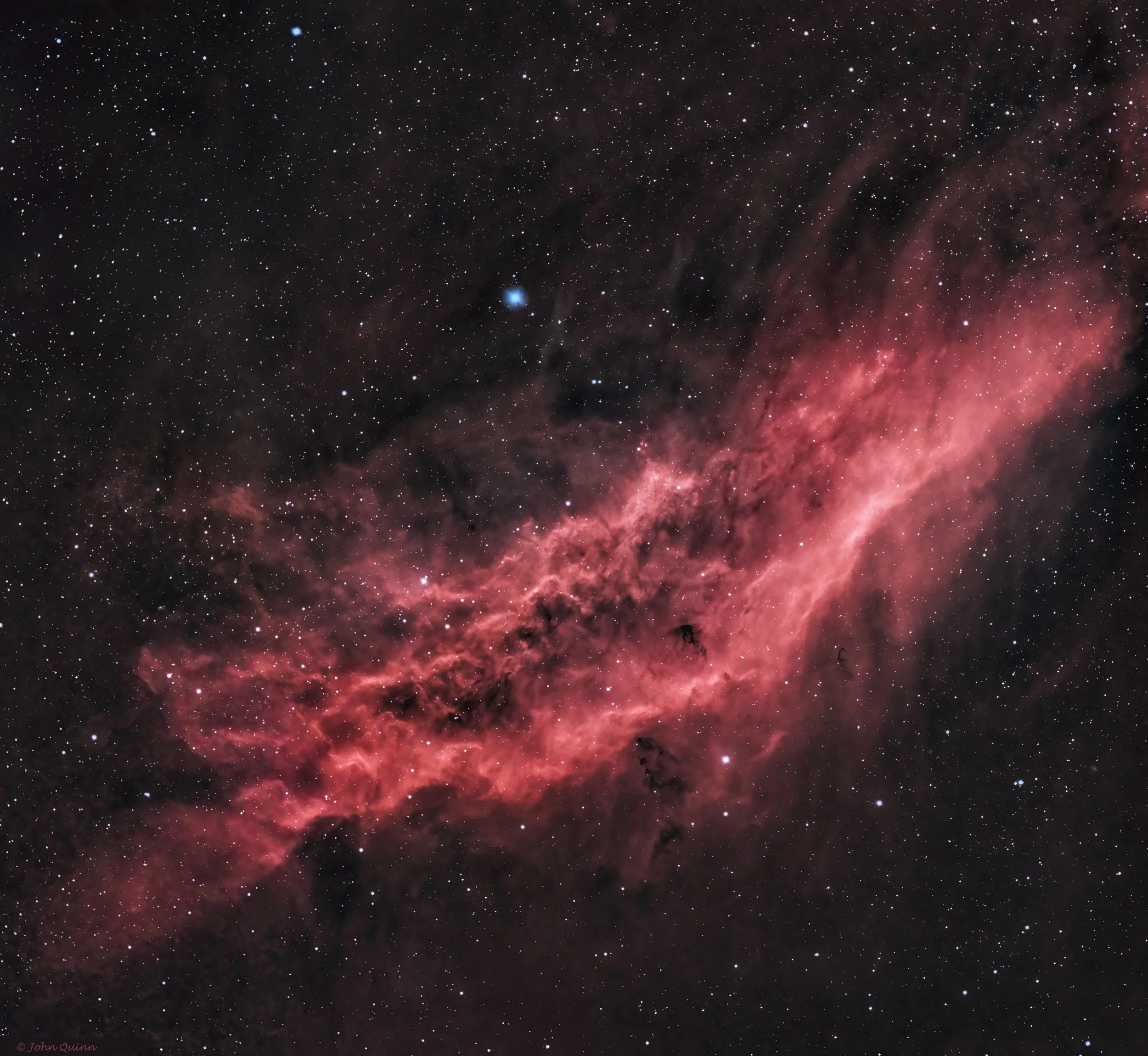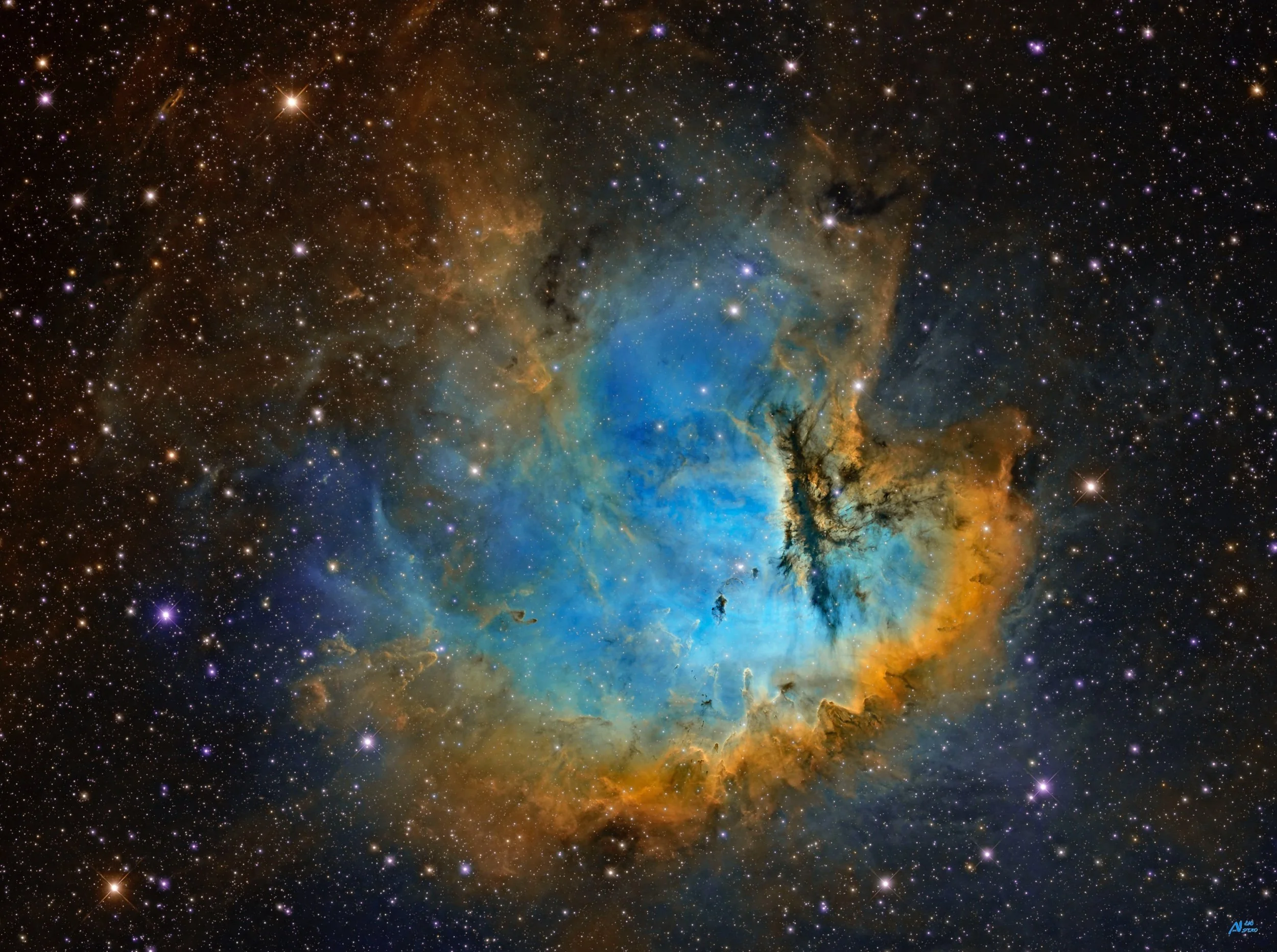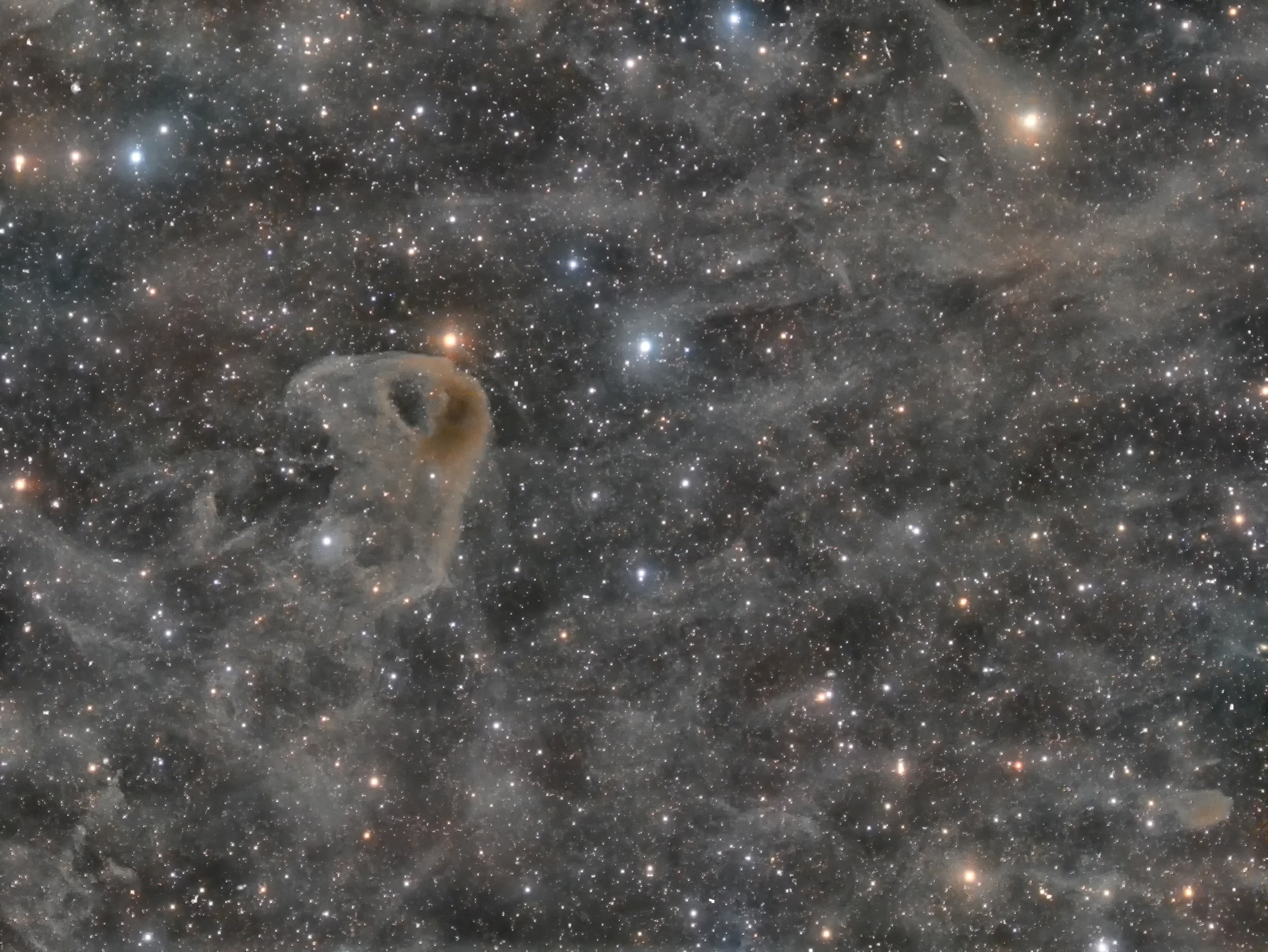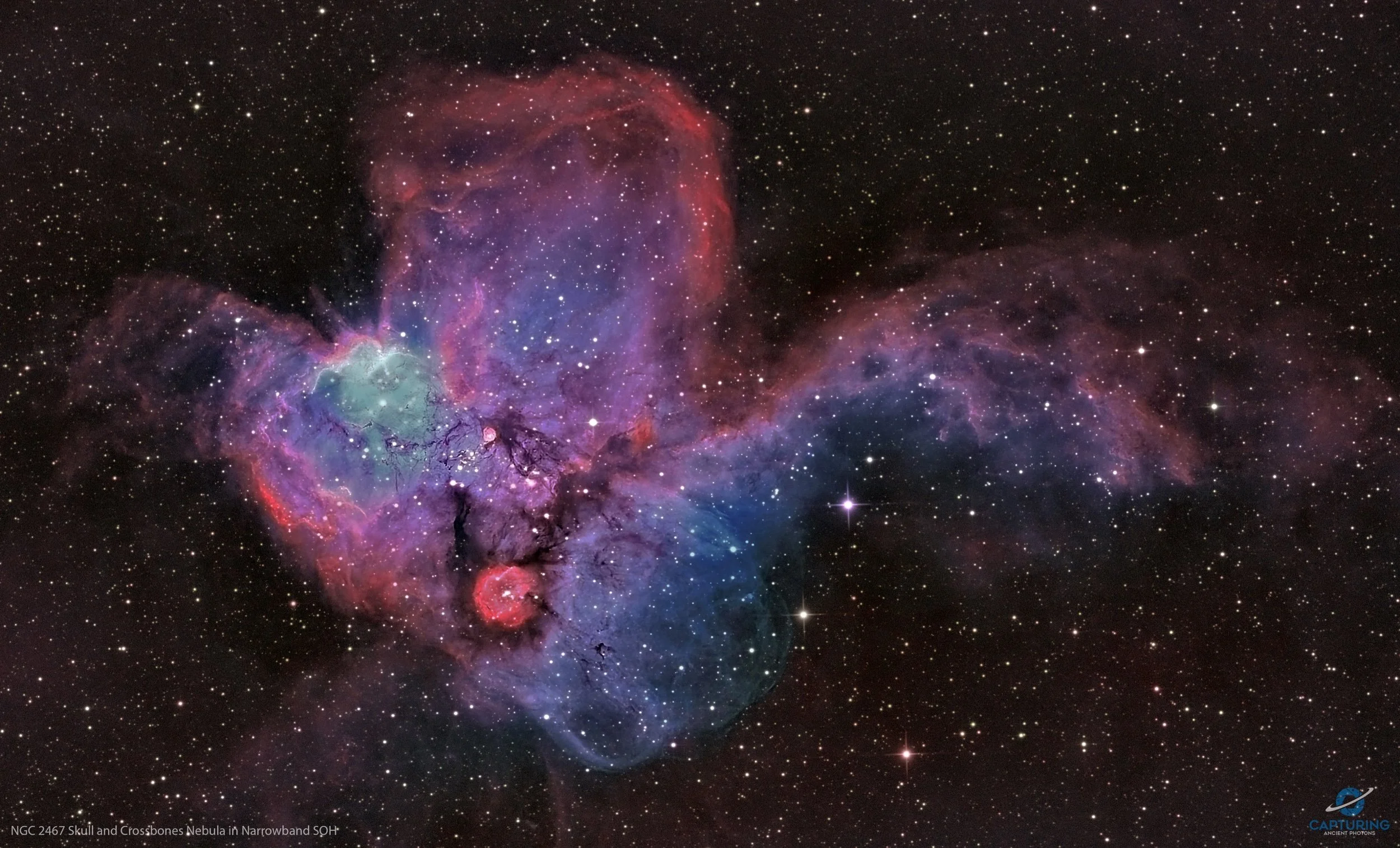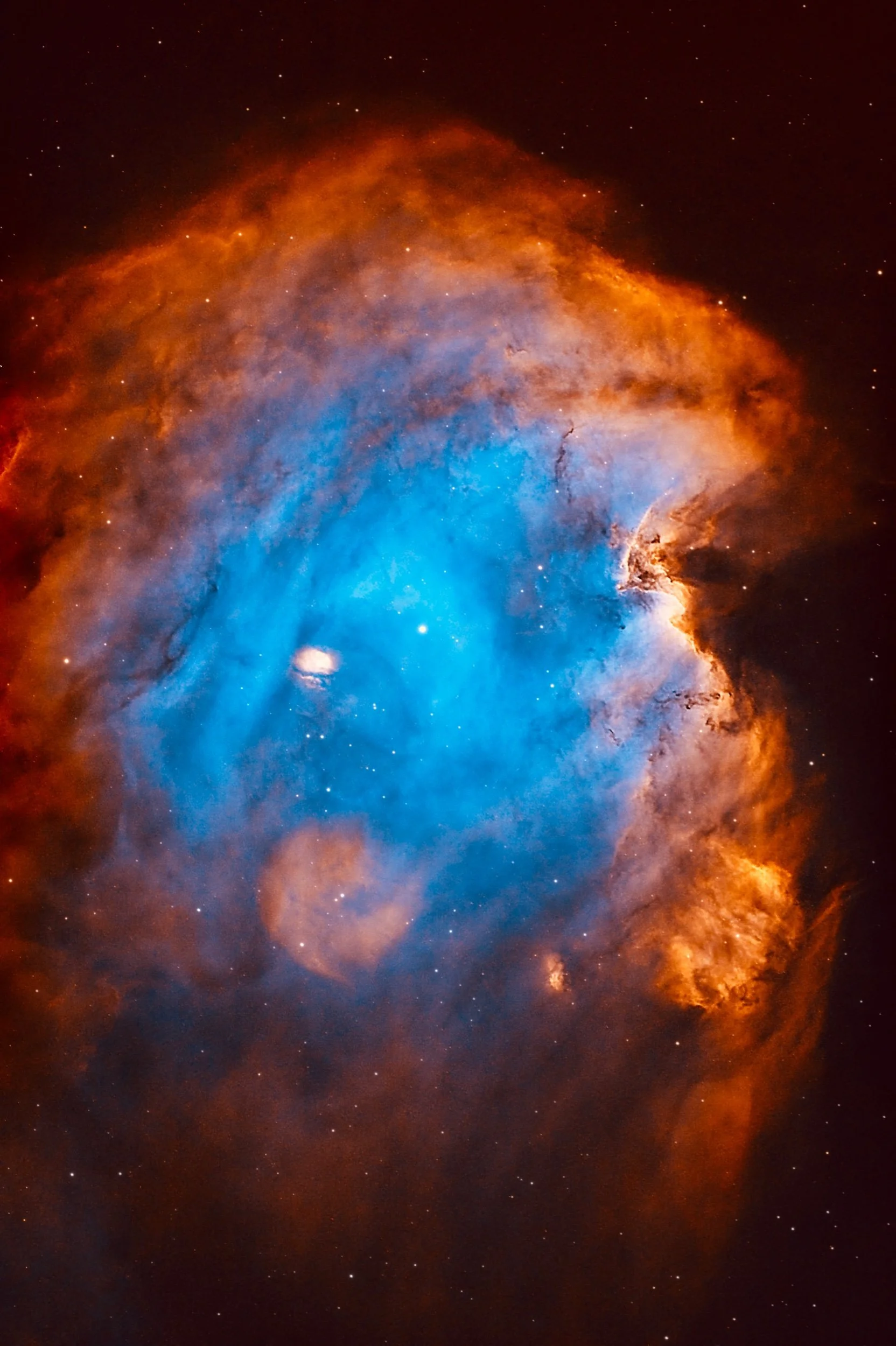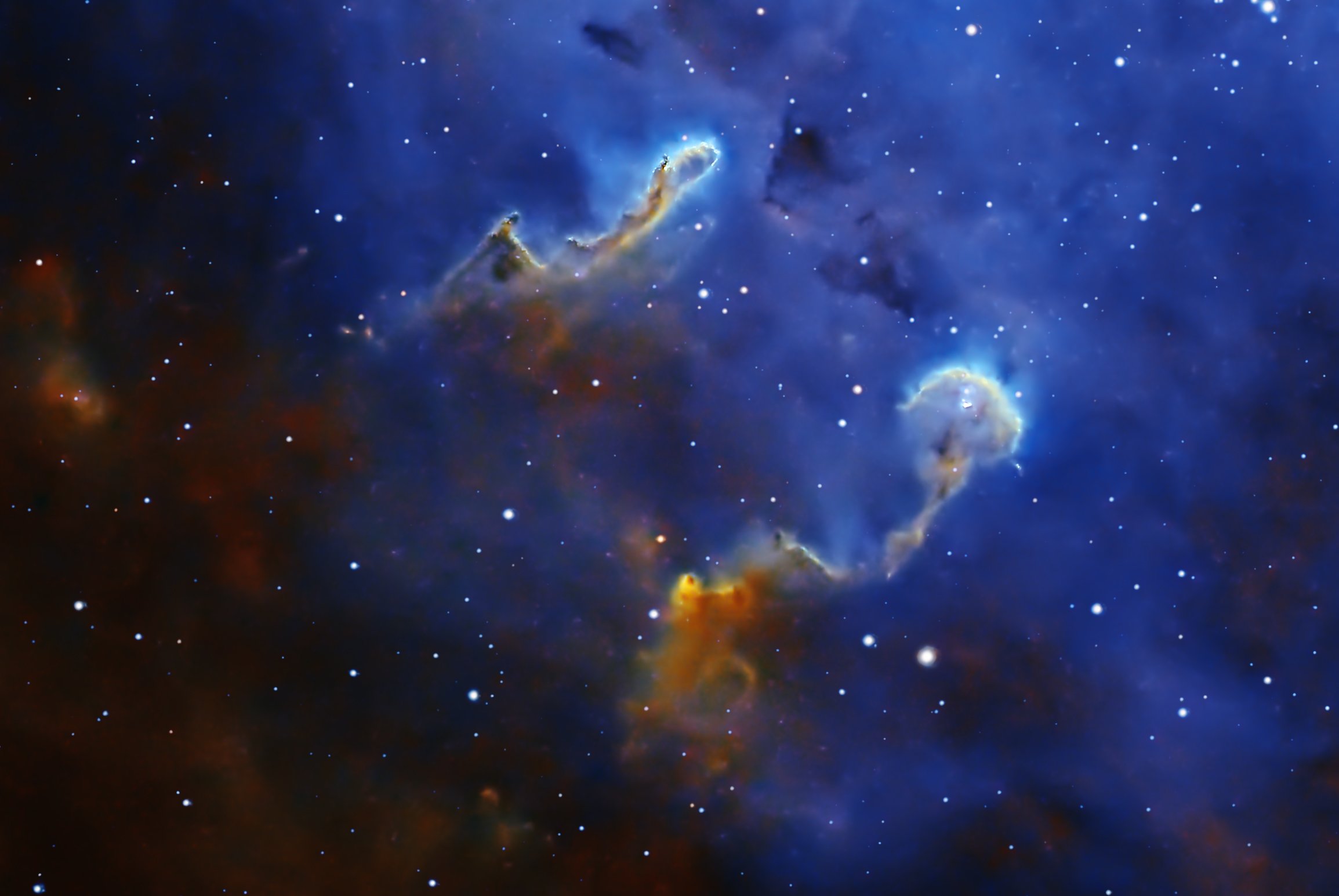
AAPOD2 Image Archives
NGC 1491 - The Fossil Footprint
Image Description and Details : Located on the edge of a vast cloud of natural gas, about 10,700 light-years away in the constellation Perseus, NGC 1491 (also called the Fossil Footprint) is an H II region (a large, low-density cloud of partially ionized gas in which star formation has recently taken place). Its central star (BD +50 886), is a young blue star with an 11.22 magnitude whose stellar winds are blowing a bubble in the surrounding gas.
Imaging telescopes or lenses: Takahashi FSQ130ED
Imaging cameras: ASI 2600MM
Mounts: Takahashi EM 400 Temma 2M
Guiding telescopes or lenses: Takahashi FS60CB
Guiding cameras: QHY CCD QHY 5 II
Focal Extender / Reducer: None
Software: Sequence Generator Pro SGP (for capture) PHD 2 (guiding), Astro Pixel Processor & PixInsight,
Filters: Astrodon Ha (3nm), Astrodon OIII (3nm), Astrodon SII (3nm),
Accessories: ATIK EFW3, SeleTEK2 controlling Robofocus Focuser.
Original Image : 5100 x 3400
Dates: 5th - 18th Jan 2023
Frames:
Astrodon Ha 42 x 10'
Astrodon OIII 36 x 10'
Astrodon SII 30 x 10'
Total integration = 18 Hours.
Copyright: Brendan Kinch
A "hole" in the sun
Image Description and Details : AR3190 is one of the largest sunspots of the new solar cycle 25, when we observe it with a telescope it is really impressive to see this dark spot on the surface of our star.
What is this dark hole? Did the surface of the sun go out in that area? None of this, it's just an illusion! Sunspots are "cooler" than the surrounding surface due to the action of strong magnetic fields and this creates the illusion of a dark spot, but in reality it is still very hot, about 4000K in the umbra (the dark core of sunspot). The darkness of a sunspot is only a contrast effect.
To take this picture I used a Sky Watcher Maksutov 180 telescope, a Baader astrosolar film, a Powermate 2X, a Player One Photosphere filter, and a Player One Apollo-M camera.
Copyright: Eduardo Schaberger Poupeau
Sh2-170 - The Little Rosette Nebula
Image Description and Details : Sh2-170, also known as the Little Rosette Nebula. It is the lower part or the ‘dot’ within the Question Sign Nebula and is situated in the Cassiopeia constellation, around 7,500 lights away.
Celestron 14” Edge HD with .7x reducer at F/8
Celestron OAG and a ZWO 174mm guide camera
Ioptron CEM 120 mount
ZWO 2600MM Pro cooled to -10° / gain 100.
ZWO ASIAIR pro+
ZWO EAF focuser
Chroma 3nm filters with ZWO 7x36mm EFW
Processed in Pixinsight.
Shot from my backyard, bortle 8.
Sii - 5 min subs = 14.4 hrs.
Ha - 5 min subs = 15 hrs.
Oiii - 5 min subs = 8.7 hrs.
Total integration time = 38.1 hrs.
Copyright: Richard McInnis
The Fish head nebula (IC 1795)
Image Description and Details : IC 1795 (Fish head), is a diffuse nebula identifiable in the constellation of Cassiopeia, towards the border with the Giraffe. It is part of an extensive nebular complex that is the site of very active star formation which includes the areas W4 (Heart Nebula) and W3 (IC 1795 and NGC 896).
For the acquisition of the signal, very narrow band filters (3nm) were used in order to create the Hubble palette which associates HII, OIII and SII to the G, B and R channels.
A total of 21 hours of exposure were required, carried out in the Valle degli Ulivi (Taranto-Italy) at 80m a.s.l.
Technical data
----------------
Sky: SQM 20,45
Lights: 83x300s Ha(3nm) + 80x300s OIII(3nm), 88x300s SII(3nm)
Telescope: Skywatcher Quattro 250P + GPU Coma corrector
Camera: QHY 294M Pro
Mount: Sky-Watcher AZ-EQ6 GT
Filters: Optolong SHO 3nm
Processing: DeepSkyStacker, Photoshop CC, PixInsight
Copyright: Tommaso Massimo Stella
Comet 2022 E3 (ZTF)
Image Title: Comet 2022 E3 (ZTF)
Image Description and Details : Comet 2022 E3 (ZTF) is one of the brightest comet this year.
A pretty comet with blue-green nucleus.
Nikon Z50 + Sigma 70-200 Sport at 200mm F3.5
Skywatcher StarAdventurer Mini
217 x 15" ISO 1600
Copyright: Enol M.
The Praying Mantis
Image Description and Details : Just above the witch in the sky hovers a praying mantis…..
It fascinates the mind that our ancestors chose to name many objects in the sky based on animals and some of the names which come to mind are the Scorpion, the Bear and even a Dragon. Continuing in the same vein and keeping to traditions, in my mind’s eye I see NGC 1788 as a Praying Mantis. That it lies in close proximity to IC 2118, the Witch Head nebula gives it an even more sinister character. The star Beta Eridani / Cursa shines brightly creating a strong halo while the ionised hydrogen gases in the region contrast it in bright red emissions. The blues from the reflection nebulae and the dust in the region all combine together to form a rich smörgåsbord of color….
Telescope: Takahashi E160ed
Camera: Zwo 6200mm pro
Mount: Software Bisque Paramount Mx+
Observatory : Deep Sky Chile
L = 101 x 300s = 8h25m
R= 101 x 300s = 8h25m
G= 101 x 300s = 8h25m
B= 101 x 300s = 8h25m
Ha = 101 x 600s = 16h50m
Total integration = 50h30m
Acquisition Software = Voyager Advanced
Processing Software = PixInsight
Copyright: vikas chander
IC 1396
IC 1396 is a stunning emission nebula located in the constellation Cepheus. The bright central star, HD 206267, ionizes the surrounding gas, causing it to glow in brilliant hues of red and blue. The nebula's distinctive shape, often referred to as the "Elephant Trunk," is created by dense columns of gas and dust that shield the nebula's interior from the ionizing radiation. The trunk of the elephant is also a site of ongoing star formation, with several young stars visible within the structure. IC 1396 is a beautiful example of the ongoing processes of stellar birth and death in our galaxy.
M45 (Pleiades) in HOORGB
Image Description and Details : M45 (Pleiades) in HOORGB, 98 hours taken over the course of 19 nights.I've wanted to take this picture for a couple of years, but whenever I could get to my dark sky site, it was cloudy. The stars finally aligned (literally) and I was able to get a good amount of RGB data from my dark sky site this winter.During my research for taking this photo, I noticed that some images had small amount of faint Hydrogen Alpha immediately around M45, so I figured I'd pile on some HA data for my wide field image and see if any more hydrogen would present itself...I was pleasantly surprised to find some wispy streams of hydrogen that I'd never seen before, right outside of the star cluster.The RGB data was taken from my dark sky site in Bone Cave, TN. The narrowband data was taken from my backyard in Nashville, TN.Imaging details:Imaging Telescope: TPO UltraWide 180 f/4.5 Imaging Camera: ZWO ASI2600MC Pro Mount: Sky-Watcher EQ6-R Pro Filters:Baader Fringe Killer 2"Optolong L-eXtreme 2" Accessories: ZWO ASIAIR Plus, ZWO EAFSoftware: Adobe Photoshop, Aries Productions Astro Pixel Processor (APP), Pleiades Astrophoto PixInsightGuiding Telescope: ZWO 30mm Mini Guider ScopeGuiding Camera: ZWO ASI290MM Mini Dates:Nov. 18, 2022, Nov. 19, 2022, Nov. 20, 2022, Nov. 21, 2022, Nov. 22, 2022, Nov. 23, 2022, Nov. 28, 2022, Nov. 30, 2022, Dec. 12, 2022, Dec. 15, 2022, Dec. 16, 2022, Dec. 17, 2022, Dec. 18, 2022, Dec. 19, 2022, Dec. 20, 2022, Dec. 23, 2022, Dec. 24, 2022, Dec. 25, 2022, Dec. 27, 2022, Jan. 1, 2023Frames:Baader Fringe Killer 2": 538×240″ (35h 52′) (gain: 100.00) -10°COptolong L-eXtreme 2": 467×480″ (62h 16′) (gain: 100.00) -10°CTotal Integration: 98h 8′Darks: 60Flats: 60Flat darks: 100
Copyright: Copyright: Jeffrey Horne
NGC 1360
Image Description and Details : NGC 1360, also known as the Robin's Egg Nebula, is a planetary nebula in the Fornax constellation. It is estimated to be between 1200 and 1800 light years from Earth.
Scopes: APM TMB LZOS 152 Refractors and Celestron C14 Edge HD
Cameras: QSI6120wsg8 and ZWO ASI6200MM Pro
Mounts: 10Micron GM2000 HPS and 10Micron GM3000 HPS
A total of 35 hours 30 minutes (HaOIIIRGB)
More information at
Copyright: Copyright: Peter Goodhew, Sven Eklund
Thors helmet
Image Description and Details : Integration time: ~12 hrs of Hydrogen, Oxygen and RGB data from my Bortle 4/5 backyard
Telescope: Skywatcher Esprit 120 ED APO
Imaging Camera: ZWO ASI 294MM Pro
Guiding: Starfield 50mm guide scope with ZWO ASI290MM guide camera
Filter: Optolong Ha, Oiii and RGB filters
Mount: Skywatcher EQ6R-Pro
Calibration: Flats and flat darks
Hardware Control: ASIAIR Pro, Pegasus Power Box, ZWO EAF and EFW
Processing: The selected images were pre-processed and processed using Pixinsight.
Copyright: Jason Dain 2023
California nebula
Image Description and Details : NGC 1499 and IC 2005 combine to make up what is known as the California Nebula due to its long and narrow outline. About 1000 light years from Earth, this emission (primarily hydrogen alpha and beta) nebula is at least partially energized by the bright massive star above it in this image (Xi Persei with a total luminosity estimated at 263,000 times that of our sun).
RASA 8, ASI071 MC PRO, EQ6-R PRO, ASIAIR PRO, Radian Triad Ultra, about 26 cumulative hours, Bortle 6
Copyright: John Quinn
Ngc281
Image Description and Details : NGC 281 is a HII region located about 10 000 light-years from Earth in the constellation Cassiopeia. With a diameter of about 100 light-years, it is part of the Perseus Arm. It includes or is close to the open cluster IC 1590, the double star HD 5005 and several Bok globules. It is visible through an amateur telescope in areas where the night sky is sufficiently dark. It is sometimes unofficially called the Pacman Nebula because of its coincidental resemblance to the eponymous hero of the arcade game Pac-Man.
This emission nebula was discovered by the American astronomer Edward Barnard in 1881.
Photo taken in Normandy France.
Equipment: Newton Skyvision 250/900 (F/D 3,6) on Skywatcher EQ8 mount, ZWO Asi 6200MM camera
36 H in S,H,O
Copyright: Francis Bozon
NGC 2030 - The Tarantula Nebula
Image Description and Details : A huge celestial furnace of star production, located outside our galaxy in the Large Magellanic Cloud.
Just over 75 hours of integration using narrowband filters were used to create this 2 panel mosaic.
William Optics RedCat51
ZWO ASI294MMPro
Skywatcher NEQ-6 Pro
Taken from Perth, Western Australia
Copyright: Daniel Faull
Moon O'Clock
Image Description and Details : The first Full Moon of 2023 is in the sky tonight opposite the Sun at 23:08 UTC. Big and beautiful, the Moon at its brightest phase should be easy to spot. Still, for quick reference images captured near the times of all the full moons of 2022 are arranged in this dedicated astro-imaging project from Sri Lanka, planet Earth. The day, month, and a traditional popular name for 2022's twelve full moons are given in the chart. The apparent size of each full moon depends on how close the full lunar phase is to perigee or apogee, the closest or farthest point in the Moon's elliptical orbit. Like the 2022 Wolf Moon at the 1 o'clock position, tonight's Full Moon occurs within a about two days of apogee. But unlike in 2022, the year 2023 will have 13 full moons that won't all fit nicely on the twelve hour clock.
Copyright: Niveth Kumar
The baby eagle
Image Description and Details : Fotografía realizada desde los cielos de Extremadura (spain)
Esprit-100
OrionAtlas-EqG
L-200x180.Rgb-90x180
Copyright: Ángel González Gordillo
NGC 2467 Skull and Crossbones Nebula
Image Description and Details : NGC 2467 or the Skull and Crossbones Nebula is an active stellar nursery lying in the southern constellation of Puppis located around 17,000 light-years away from Earth.
56 x 600s SOH subs shot @0C spread across 4 nights for a total integration time of about 9.5hrs
Equipment used:
Skywatcher 10" f4 Newtonian 250P
Skywatcher F4 Aplanatic Coma Corrector
Skywatcher NEQ6 Pro Hypertuned by Astronomy Academy Perth
ZWO ASI2600MM Pro Cooled Camera
Primaluce Sesto Senso2 Electronic Focuser
William Optics Uniguide 50/200mm guidescope
ZWO ASI290MM Mini Guide Camera
ZWO Electronic Filter Wheel
Antlia Pro 36mm unmounted filters
Rollon rolloff modified shed observatory
Bortle 5
Data acquisition software: NINA Astronomy Software
Processing software: PixInsight and Photoshop CC
Copyright: Capturing Ancient Photons
Owl cluster
Image Description and Details : Here’s some space gems 💎 the open star cluster NGC 457 also known as the owl cluster, it is an open star cluster 7,900 light away from the sun. It has an estimated age of 21 million years.
Taken Northwest Missouri September 30-2022 at the Backyard country observatory, using a Orion 8 inch f3.9 newtonian astrograph, with a coma correcter. Canon 60d unmodified, autoguider orion starshoot 60mm guide scope, all on a celestron AVX mount.
5 hours of 3 minutes subs RAW exposures, ISO-1250
Processing. Pixlinsight dynamic crop, dynamic background ext, non linear stretch in histrogram tran, NoiseXTerminator, BlurXTerminator, added luminous mask experimental transformation, star mask using the morphology trans for star reduction, added a luminous mask used curves, for saturation’s,
Photoshop: levels, selective color.
Copyright: Jared Bowens
Monkey Head Nebula
Image Description and Details : NGC 2174 / Sh2-252 - The Monkey Head Nebula, located about 6,400 light-years away in the constellation Orion.
Celestron 11” Edge HD with .7x reducer at f7. Celestron OAG with 174mm guide camera, CEM 70 mount, ZWO 2600 mm pro, ASIAIR pro+, ZWO 7 x 36mm EFW, ZWO EAF, 5 min subs shot with Chroma 3nm filters in SHO palette. 9 hours total. Processed in Pixinsight. Shot from my backyard, bortle 8.
Copyright: Richard McInnis
Ic447
Image Description and Details : IC447, Reflection Nebula in Monoceros. RGB + Duo narrowband OSC.
🗓 December, 28th to 30th. 2022
📍 Giruá, RS, Brazil. Bortle 4.
🔭 FotonAstro Astropipe 200MM F4 Newtonian Astrograph / AM5 Eq Mount
📷 asi2600mc camera
🕶 No Filter / Antlia ALP-T duo narrowband
- 113 x 180s (5,65h) No Filter (built in uv/ir asi2600mc)
- 32 x 300s (2,66h) with antlia duo narrowband filter
🧑💻 pixinsight, photoshop
Copyright: Martin Konrat
Sim 129 & 130 - The Tadpoles
Image Description and Details : This image was rather a surprise to me. I started shooting it last year and managed to scratch out a few more hours of data on it earlier this month. It's part of a much wider field, but when I zoomed in on the two objects that give the nebula its name, I was pleasantly surprised at the detail that came through.
The Tadpoles Nebula (I'll post the wide field in a day or two), designated IC 410, hosts a star cluster catalogued as NGC 1893. That cluster contains a number of very young, hot stars that formed in the larger nebula three million years ago and they have been busy sculpting the surrounding gasses with hot stellar winds ever since resulting in the two beauties in this shot designated Sim 129 (left) and Sim 130 (right).
The two tadpoles are each about 10 light years in length and are likely the source of ongoing star formation.
Details: Celestron EdgeHD 1100 telescope; 10Micron GM1000 HPS mount; ZWO ASI6200MM camera; Chroma 3nm narrowband filters; 18hrs exposure time.
Copyright: the Accidental Astronomers



